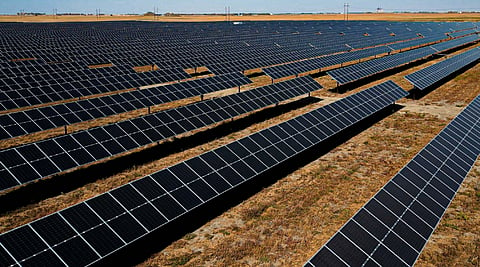

The tiny hamlet of Caroline, home to just 500 residents northwest of Calgary, is at the centre of a growing debate over how rural communities can balance much-needed tax revenue with the desire to preserve their unique way of life.
At issue is a proposed 57-acre, 14-megawatt solar farm that supporters hail as an economic lifeline, but opponents fear could alter the character of the village forever. The project, which buts up to the northern border, is almost the size of the town itself.
After years of regulatory hearings and delays last year’s moratorium on renewable energy development, the project finally received approval on Feb. 28.
Local resident and project opponent Penny Judson said she and other residents found out from the Alberta Utilities Comission just before 5 pm on a Friday afternoon. What ensued was a furious flurry of phone calls to government officials and an impromptu door knocking campaign.
“We’re furious,” she told The Western Standard. “We’re quite frustrated by this whole process… we have to stand up to this bulls---.”
The project, spearheaded by PACE Canada LP, is expected to generate $17 million in capital spending and reduce carbon emissions by 12,300 tonnes annually.
But it would also cover a tract of farmland within Caroline’s boundaries on land that had been zoned for residential development, raising concerns about long-term land use planning.
For local politicians the project represents an important opportunity. Caroline, like many small communities in Alberta, struggles with a tax base that leans heavily on homeowners. Without significant industrial or commercial development, property taxes remain high for residents.
Interim Mayor John Rimmer told CBC last fall that the solar plant would help shift that burden.
But it has also sparked controversy.
Judson is helping spearhead the Caroline Concerned Citizens Group (CCCG), and has called for more information on the solar farm’s potential impacts on wetlands, wildlife and noise levels. She also complains residents weren’t consulted.
Critics like her worry about the visual impact of hundreds of solar panels, the potential for increased land future reclamation costs and how the heat and reflections will affect local ecosystems — not to mention properties adjacent to the site, including a playground for children.
Judson notes that residents like herself chose Caroline over the city precisely for its laidback rural vibe in the shadow of the Rocky Mountains.
“It’s not just about the tax revenue,” he said. “We need to ask ourselves: what does this mean for our community in the long-term?”
"We have to stand up to this bullshit..."
Caroline resident Penny Judson
Russell Barnett, who is also a member of the CCCG — and a chartered accountant — complains that PACE isn’t a solar power producer per se; rather it’s a German-based limited partnership that develops solar projects to attract greenhouse gas credits before selling the facilities and moving on.
In February of last year, PACE sold off its 50% interest in the 61 Mw Joffre solar park north of Calgary to Concord Green Energy. Terms weren’t disclosed but it cost $65 million to build.
Barnett said it can only play that arbitrage precisely because Alberta’s is the only deregulated power market in Canada. In any event, Joffre is also home to one of the largest petrochemical complexes in Canada so solar power makes more economic and logistical sense.
Nonetheless, the controversy in Caroline is playing out against a broader policy debate over the role of renewable energy in Alberta’s electricity grid. At least a dozen similar projects are being planned or built across Alberta.
While the UCP government has encouraged renewable energy investment, in 2023 it also imposed a six-month moratorium on new approvals for renewable projects, citing concerns over land reclamation and the loss of agricultural land and reclamation of the panels themselves once they’ve outlived their useful life.
The solar debate comes at a pivotal time for Caroline, which lost its status as a village and become a hamlet within Clearwater County effective Jan. 1.
The amalgamation, driven by a shrinking population and an unsustainable tax base, reflects a broader trend in rural Alberta, where small municipalities are increasingly merging with larger counties to stay financially viable.
While local leaders hope that joining Clearwater County will bring long-term stability, the transition raises questions about how major decisions — such as siting industrial projects — will be handled in the future.
Residents like Judson and Barnett fear the move could dilute their community’s voice in land use planning, making it harder to push back against large-scale developments.
Caroline is not alone. The town of Innisfail, which had been counting on a $4 million solar farm to help fund municipal services, paused the project on Feb. 10 due to “a significant drop in the current and forecasted pool price for (the) electricity generation market.”
With Alberta’s regulatory landscape in flux and pressure mounting on both sides, Caroline’s struggle is unlikely to be its last.
The question remains: in the face of economic pressures, how much change is too much for rural Alberta?
Judson is blunt: “It’s a load of crap as far as we’re concerned. It's obsolete, it's not even good power anymore."
